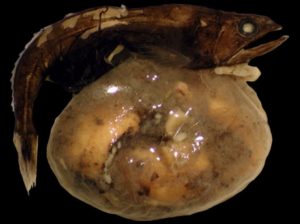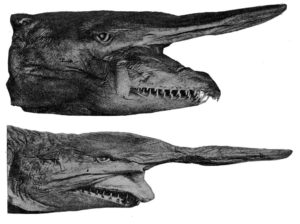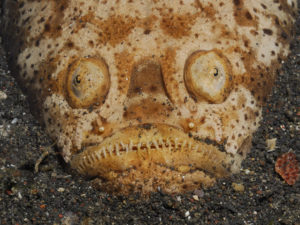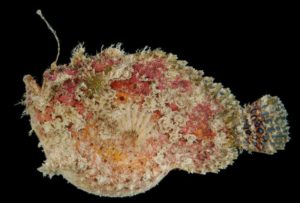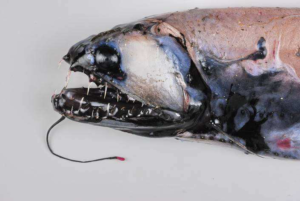Some ocean critters are cute. Some are giant, and some are weird. And some are downright unattractive. Although we hesitate to use the word “ugly,” it’s true that some marine creatures are far less fetching than others. In no specific order, then, here are eight of the ugliest ocean creatures.
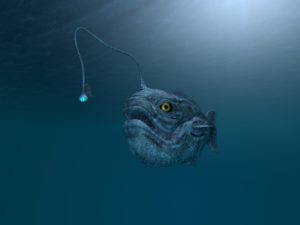
Anglerfish
The anglerfish certainly deserves a spot on the list of the ugliest ocean dwellers. This angry-faced fish inhabits the deepest, darkest depths of ocean worldwide. There are over 200 kinds of anglerfish, all boasting a giant head that features a frowning mouth full of razor-sharp teeth. Their name derives from the long filament protruding from the middle of their heads, which they use to lure prey like a fishing pole. They can distend their stomachs and jaws such that they can consume prey twice as large as their entire body. Anglerfish can range anywhere from 8 inches (20 cm) to over 3 feet long (1 m) and weigh up to 100 pounds (45 kg).
Blobfish
Next is the aptly named blobfish, which typically grows to about 12 inches (30 cm). Its face resembles that of a grumpy old grandpa whose supply of toffees has disappeared. These deep-dwellers live between 2,000 and 3,900 feet (610 to 1,188 m) below the surface around Australia, Tasmania and New Zealand, where pressure is between 60 and 120 greater than at the surface. With no gas bladder for buoyancy, the blobfish uses its gelatinous flesh, which is slightly less dense than water, to the same effect. It expends little energy to hunt, waiting for prey to float by. Unfortunately, deep-sea trawling threatens the blobfish as it’s often caught up as bycatch in bottom-trawling nets.
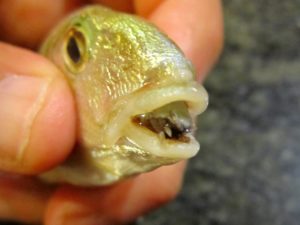
Tongue-Eating Louse
Our next critter, the tongue-eating louse, has a lifestyle as unappealing as its looks. Many of us have seen images of cute clownfish with their mouths open and what appears to be tiny eyeballs staring out where their tongue once was. That’s the Cymothoa exigua, or tongue-eating louse, a parasitic isopod that affects not just clownfish but other types of fish as well. The parasite enters fish through their gills, and then severs the blood vessels on the tongue, which causes it to die and fall off. The louse then acts as the fish’s brand-new, fully functioning tongue. It is the only known parasite to functionally replace a host’s organ. These parasites are quite widespread, found all around the world.
 Black Swallower
Black Swallower
The phrase “your eyes are bigger than your stomach,” applies perfectly to our next entrant, the black swallower. This small deep-sea fish has worldwide distribution and lives at depths of 2,300 to 9,000 feet (700 to 2,745 m). Although the largest specimens only reach 9.8 inches (25 cm) long, they can swallow prey up to twice their length and 10 times their mass, due to their distensible stomach and swinging lower jaw. Black swallowers sometimes consume fish so large that their unfortunate victims begin to decompose before they are digested. The resulting release of gas from the corpse can sometimes force black swallowers to the surface, which leads to their demise as well.
 Goblin Shark
Goblin Shark
Among the other creatures on our list, have the beautifully named goblin shark. Humans know very little about these secretive pelagics, due to few sightings and their relative depths of greater than 330 feet (100 m). These pink-skinned sharks are recognizable for their giant proboscis and protruding jaws. Goblin sharks may be ambush predators, as they are not fast swimmers. It has low-density flesh and a large, oily liver that makes it neutrally buoyant. This would allow it to drift slowly toward its prey with minimal detection. Most sightings take place near Japan, although individuals have been caught in all three major oceans.
Stargazer
The slightly creepy stargazer is a staple of the muck-diving experience around Lembeh in Indonesia. These wide-eyed fish bury themselves in the sand, so much so that only the bulging eyes on top of their heads and their fang-filled mouths are exposed. When prey swims close enough, the stargazer ambushes its victim. They inhabit both shallow and deep waters, and attain lengths of 7 to 35 inches (18 to 90 cm). As if they weren’t strange enough, these fish can also deliver electric shocks.
 Marble-mouthed Frogfish
Marble-mouthed Frogfish
Like many frogfish, this next creature holds a place dear to the heart of many divers. As with all frogfish, the marble-mouthed variety does not swim. These creatures instead use their pectoral fins to “walk” across the sea floor. Rarely moving, they’re usually extremely well camouflaged, not for defense, but for predation. They hide in plain sight, wiggling the lure on their head, which resembles a shrimp, to attract unsuspecting prey. This critter’s mouth can expand to 12 times its resting size, enabling it to catch creatures of varying sizes. They are carnivores, mostly eating fish and crustacean. However, they are also cannibals, preying on other frogfish too.
 Snaggletooth
Snaggletooth
The final spot on our list is reserved for the demonic-looking snaggletooth or stareater fish. This creature, with its luminous red chin used to attract and lure prey, is a powerful predator that lives in deep waters between Australia and New Zealand. Not much is known about these fish, which can grow to about 2 feet (.6 m) long and have a mouthful of sharp-looking fangs.
So, there you have it, our top eight ugliest ocean creatures. If you’ve seen any — or have any to add to the list — we’d love to hear about it.


